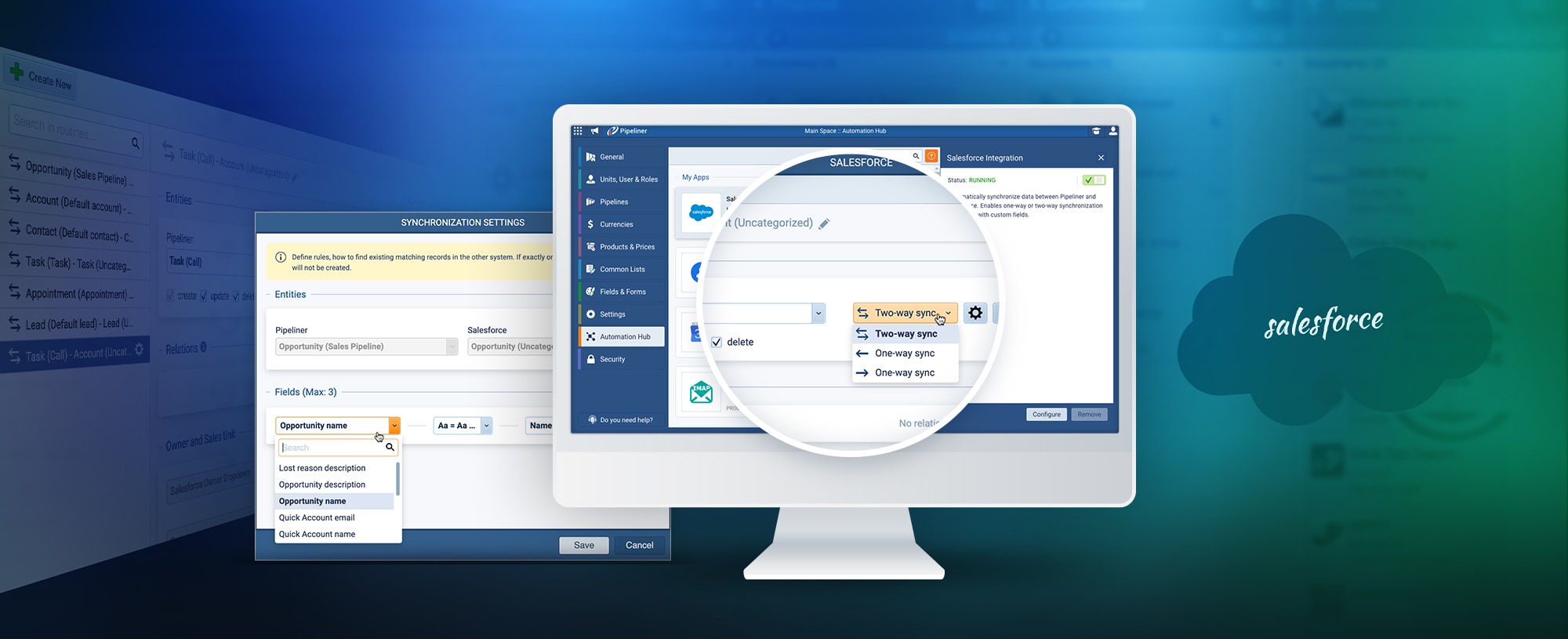Why It’s Important to Get it Right
There are numerous reasons why a modern CRM productProduct Product refers to anything (an idea, item, service, process or information) that meets a need or a desire and is offered to a market, usually but not always at a price. such as Pipeliner CRM needs to be onboarded in the right way.
Technology has taken many leaps and bounds forward in the last few years. An incredible example is GitHub, the open-source repository, which tripled in scope in the last few years. Today there are an astounding 73 million programmers registered exclusively on GitHub, with over 200 million repository projects.
Interconnectivity has experienced major advances. Going back in time, connectors between applications had to be programmed. Coming forward we have API technology—which is consistently innovated—along with webhooks and other technology that will allow applications to plug and play with each other, with immediate dataData Data is a set of quantitative and qualitative facts that can be used as reference or inputs for computations, analyses, descriptions, predictions, reasoning and planning. sharing.
Automation of workflows and artificial intelligence have also been through fundamental innovations. Team members can put their attention onto higher priority work.
The Shift in OnboardingOnboarding Onboarding is the process or act of introducing a new customer to your product or service; or integrating a newly hired employee into your workforce or team.
Innovations such as these have resulted in shifts in onboarding—it truly isn’t what it used to be. Traditionally onboarding consisted of a one-time setup and onboarding, training, and then that was it. The software vendor or publisher didn’t contact the purchaser after that. The customerCustomer Customer is an individual or an organization that purchases a product or signs up for a service offered by a business. was on their own and would either continue with the product or switch to another after a time. They were never contacted again by the vendor.
Point solutions are the only applications still retaining this approach. For example, my company used GoToMeeting videoconferencing for four or five years. When we switched to Zoom, we didn’t hear from the publisher or vendor at all. We then used Zoom for the next five years, and have recently changed to Microsoft Team Meeting. During the time we used Zoom, we spent a considerable amount of money on license purchases, perhaps as much as $50,000, and have heard nothing from them since we left them behind. It seems incredible that a company would let a $50,000 customer walk away, but that’s how it is with point solutions—it’s more of a commodity approach. There is nothing more to learn when you have understood the basic functionally of the solutionSolution Solution is a combination of ideas, strategies, processes, technologies and services that effectively helps an organization achieve its goals or hurdle its challenges..
An approach such as this is not possible for a process-driven CRM solution like Pipeliner CRM. Society is changing, processes are changing, industries are changing, and companies are changing internally—which means that the operating system for a company, the CRM system, has had to reflect these exponential changes. All of this has meant that onboarding, too, has had to change.
Although there is increasing complexity within today’s digital world, we program Pipeliner utilizing cybernetic principles—the science of simplicity. Despite its robust feature set, Pipeliner is amazingly simple in its approach and ease of use. We’ve also provided more video and other contentContent Content refers to a material or document released in various forms (such as text, image, audio, and video) and created to inform, engage or influence specific audiences. on our features than any other CRM vendor in the market, to make it as easy as possible for companies and users to stay current.
It’s the Customer Who Is Complex
In the area of CRM implementation, it is the customer who is the source of real complexity. To deal with this, a customer must have a clear picture of how they need to integrate CRM into their own organizationOrganization Organization is a cohesive group of people working together and formally bound by a shared identity (e.g., one team, company, club, etc.) and a common purpose (e.g., business growth, athletic victory, etc.).. This integration should be accomplished in iterations.
It is common that a CRM system is integrated with ERP in the back end, and with ticketing systems or automation tools in the front end. Note that these are not applications that Pipeliner has attempted to develop, as we don’t believe in an “all-in-one” approach, but the “best-of-breed” approach. In today’s breakneck development pace, no solution can solve all problems and be the best at everything. Pipeliner will never attempt to develop a marketingMarketing Marketing is the field, set of actions, or practice of making a product or service desirable to a target consumer segment, with the ultimate aim of effecting a purchase. or scalable ERP or ticketing system because many better ones already exist. For ticketing, Intercom or Zendesk can be easily integrated over Zapier, so there would never be a reason for us to build our own ticketing system.
Onboarding has changed because of these integrations. Before onboarding can begin, a customer must completely understand their own challenges.
A company, before adopting a CRM system, must gain this understanding by posing questions such as:
- Who are the users of the CRM system?
- What data will the system be using?
- Where does this data come from?
- What are the processes that the CRM will be interfacing with?
Today data must equally have accessibility from anywhere, and actually must flow like a river through a company. The customer doesn’t care which department of a company they work with—all departments must have the same understanding of customer details so that the customer doesn’t have to repeat them. CRM will need to reflect this data flow as well.
Overall, a company must figure out what it wants to accomplish with CRM.
How Long Does Onboarding Take?
In a general sense, when compared to its most frequent competitors, Pipeliner CRM onboards in considerably less time.
In reality, though, onboarding will take as long as the customer is prepared. Only the customer knows, and must have to hand, the number of units, the number of users, the kinds of userUser User means a person who uses or consumes a product or a service, usually a digital device or an online service. rights the customer will require for each type of user, and all the rest of the information needed for onboarding.
Pipeliner CRM Pricing
Pipeliner’s pricing differs dramatically from our competitors. Visit our website for details.
CRM Administration
We also take a considerably different approach to CRM administration. Other CRM applications require one or more full-time specialists, and when added to the cost of the CRM system itself, this makes for a substantial investment. Pipeliner CRM requires someone who acts as an administrator, but by no means is it a full-time job. Often this function can be performed in one or two days per month by a single individual.
The person administering Pipeliner must, however, have substantial knowledge of their company operations. For Pipeliner, there needs to be someone who runs the CRM project, whether it’s the administrator or someone else. If a project is required to bring CRM up and running, and it’s a larger company, the person should have a good grasp of project management. This person will be incorporating CRM to different departments, and the person will need to understand what each department needs in terms of privileges, security, and more.
CRM will also require many different integrations through API and webhook technology.
At one time it was the sales managerSales Manager Sales Manager is an executive who leads a sales unit, team or department by setting goals and meeting targets, formulating plans and policies, designating tasks, and developing salespeople. who took charge of Pipeliner CRM, but today this is no longer the case. In fact, there is a new role showing up in companies that embraces CRM and other essential functions: RevOps. Short for RevenueRevenue Revenue is the amount of money a business generates during a specific period such as a year or a quarter; also called sales. Operations. RevOps is defined as “the strategic integration of departments to provide a better end-to-end view to administration and management. Its holistic approach is designed to break down silos between departments.” The word “silo” here refers to a business department or function that is entirely separate from others in the enterpriseEnterprise Enterprise (in the context of sales) is a relatively large organization typically composed of multiple levels, locations, and departments which need multi-layer software systems that support collaboration across a large corporate environment., which they have tended to be.
Admin Training—Or, Training the Architect
The person in charge of CRM—administrator or someone else—will require training Pipeliner CRM concepts. We created an ebook detailing these concepts, and any administrator who will be overseeing the system should read it. You can download it here.
In one sense, when it comes to administration, we’re reverting to an older training method—to a time when the requirement was reading a manual. The truth is, you can only communicate so much with videos, and it’s impossible to communicate truly interactive concepts with them. We’re covering several major topics with Pipeliner concepts, and it does take some time and study. It’s best to read these materials and then ask questions.
The administrator serves the purpose, for their company, of being the CRM system architect. Pipeliner provides many different options, many ways it can be personalized, what rights a user may have, and more. For example, particular fields and forms for certain users might be read-only or not even visible. To other users, access and rights to these will be essential. There will be different types of fields such as intelligent fields, lookup fields, redirecting fields and others. The administrator will have to understand these and be able to guide onboarding based on all these requirements.
We’re most definitely here to help, alongside our partners. Our partners are experts in Pipeliner CRM and how it is implemented.
The administrator serves as the “builder of the house” within their company, as the overall architect. Only after the house is initially built and fully functional can the people who will live in the house, the users, move in.
User Training
Users will then require training as they “move into the house.” Once the system is up and running, users can be trained in a matter of hours (as opposed to days, weeks or even sometimes months for other CRM systems).
Users take to Pipeliner CRM easily, simply because it is extremely visual. They also learn quickly to love it, as it—unlike other CRM systems they may have had to use in the past—actually empowers them to sell.
The Making of Slight Changes
Users, of course, have their own taste. Once they’ve moved into the house and have occupied it for a while, they may want to make slight changes—little things such as color and appearance. Pipeliner is a system that can instantly be changed, so we call it Instant Dynamic Visualization. No “experts” or programmers are needed.
Front-End Users Transferring Knowledge
Flexibility bears another very important aspect, especially when it comes to rep turnover. This is the handoff. When someone leaves an organization, they need to hand off their work to someone else so that the departing salesperson’s sales can continue without a hitch.
A complicated CRM application can be an overwhelming proposition. Not only does the incoming rep have to learn a complex CRM application, but must also understand the pending sales within that CRM application. If another existing rep is taking over the departing rep’s sales, it will be easier because the “new” rep already knows the CRM application. But if CRM is complex, it can also be a problem of picking up every ongoing opportunity, just because tracking them is difficult.
The hiring and training of salespeople is always costly, lengthy, and to some extent risky. The last thing you want is to add the risk of having opportunities fall through the cracks or be lost altogether.
Pipeliner CRM, once more, excels in this area. Most salespeople will be able to pick up the handoff in less than a day, a few days at most.
The Two Trends: Centralize and Decentralized
We have two trends today that, despite being opposite, are running parallel: centralization and decentralization.
The business world, along with all of society, becomes progressively decentralized as time goes on. People are working from home, and companies have realized they don’t need big, expensive central offices. Pipeliner is a prime example of that—we no longer have offices, and we have happy team members and increasing success as a business.
Everyone needs access from decentralized locations to a centralized data repository and technology hub. While Pipeliner as an organization is decentralized, as a CRM system it is the most centralized in the world. Our technology cannot be interfered with or changed by anyone, which is our architecture.
In order to be flexible, efficient and effective, these two streams of centralization and decentralization must work together harmoniously. Pipeliner certainly has all three qualifications.
You know it’s effective simply because people use it. In a decentralized environment, people need a centralized system. Pipeliner has all the capabilities. To take full advantage of them, companies must completely work out what they want to achieve with those capabilities.
Lastly, as covered in our last article on this subject, onboarding has now acquired an infinity quality. It is now done in iterations, instead of all at once.





